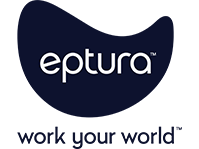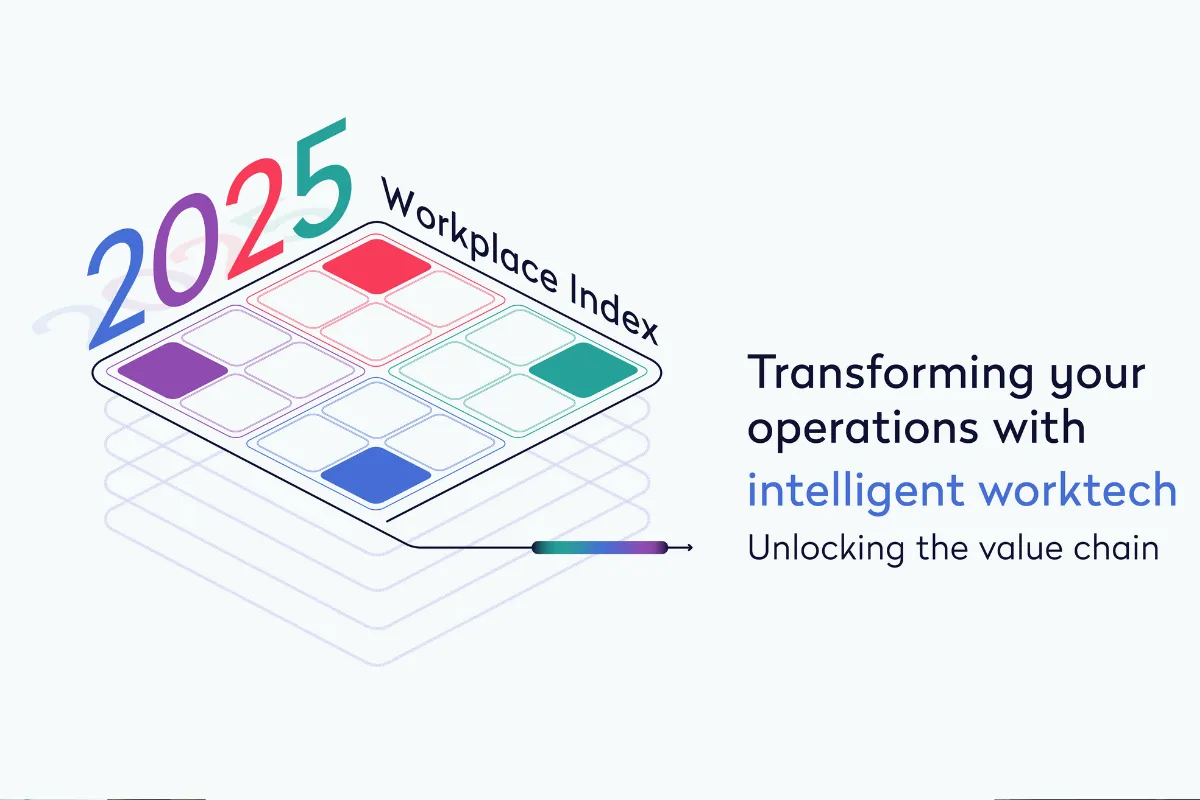
Workplace, facility, and maintenance teams across large enterprises focus on goals specific to their roles and responsibilities. They also feel they face different challenges, according to new research by Eptura. What connects them all, however, is how a unified platform with AI-backed workflows can help them collectively deliver cost-efficient, productive spaces.
The 2025 Workplace Index report integrates research with data from 25 million users of the Eptura platform and findings from a survey of 200 VP and C-suite executives from various departments, including IT, operations, HR, finance, and real estate, within large enterprises that have more than 5,000 employees.
Connecting roles to goals in facility and maintenance management
Teams at the same organization have different individual goals because each role comes with a unique set of focuses, responsibilities, and challenges.
For the Workplace Index report, we collected different data sets based on three main job functions:
- Employee experience and workplace strategy: In charge of creating a positive and productive work environment. Primary goals include aligning on a unified vision across all operational functions and increasing workplace productivity, which involves ensuring that the physical and digital spaces are designed to support collaboration, well-being, and efficiency.
- Buildings and facility management: Responsible for the physical infrastructure of the organization. Top priorities include integrating multiple workplace and building technologies to create a seamless and efficient environment and optimizing real estate to reduce costs and improve space utilization is crucial.
- Asset and equipment management: Oversees maintenance and management of the organization’s assets. The main goal is maintenance management of all assets, ensuring that equipment and resources are well-maintained, and available when employees need them.
Because it includes data from different groups, the report reveals the multitude of ways industry professionals are working toward delivering safe, secure, efficient facilities that support productivity. It also highlights the ways a unified platform with AI-backed workflows can help organizations achieve this wide variety of goals from across teams and departments.
Employee experience and workplace strategy: Unified vision
One of the top objectives for people in charge of employee experience and workplace strategy is aligning on a unified vision across all operational functions, with 31% of respondents identifying this as a key goal. This objective is crucial because it ensures that all departments and teams are working toward a common set of goals and standards. By fostering alignment, organizations can create a more cohesive and integrated workplace, which can lead to better communication, more efficient processes, and a stronger company culture. Alignment is essential for driving overall organizational success and ensuring that all efforts are directed toward achieving the company’s strategic objectives.
Another significant objective is increasing workplace productivity, cited by 26% of respondents. This goal is focused on creating an environment where employees can perform at their best. By optimizing the workplace, managers can reduce distractions, improve workflow, and provide the necessary tools and resources that enhance productivity. Prioritizing workplace productivity benefits the organization by increasing output and efficiency while improving employee satisfaction and engagement. Just behind these top two goals, at 14%, is prioritizing employee experience by making it seamless and easy to use. This goal is important because a positive and frictionless employee experience can significantly boost morale, reduce turnover, and enhance overall job satisfaction. By focusing on these objectives, workplace strategists aim to create a workplace that is not only productive but also enjoyable and supportive for all employees.
Buildings and facility management: Integrated systems
An important goal for people in charge of buildings and facility management is the integration of employee, workplace, and asset solutions, with 23% of respondents identifying this as a key objective. By integrating these solutions, facility managers can enhance employee productivity, improve workplace satisfaction, and ensure that assets are utilized effectively. Integration can lead to better resource allocation, reduced operational costs, and a more cohesive and responsive facility management system.
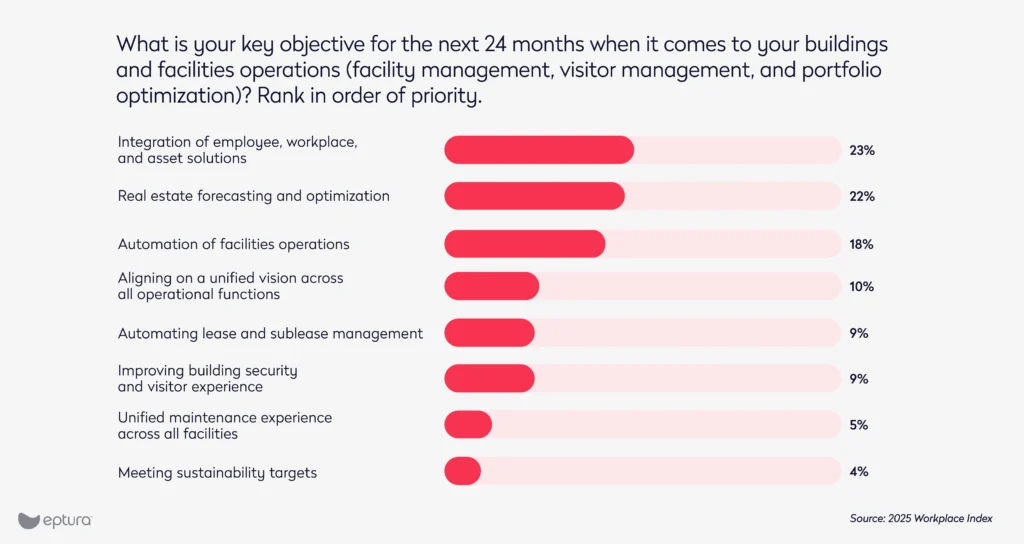
Another significant goal is real estate forecasting and optimization, cited by 22% of respondents. The focus here is on making data-driven decisions to optimize the use of real estate assets, ensuring that space is used efficiently and cost-effectively. Real estate forecasting helps facility managers anticipate future needs and make strategic decisions about space allocation, which can lead to significant cost savings and improved operational efficiency.
Just behind these top two goals, at 18%, is the automation of facilities operations. Automation can streamline routine tasks, reduce human error, and free up staff to focus on more strategic initiatives, which is particularly important for enhancing the overall efficiency and reliability of facility management operations.
Asset and equipment management: Centralized solution
A top goal for people in charge of asset management is centralized maintenance management of all assets, with 20% of respondents highlighting this as a key objective. Centralized management helps teams ensure they can consistently monitor and maintain assets, leading to more reliable operations and better resource allocation. Asset managers can reduce downtime, minimize unexpected failures, and extend the lifespan of their assets, saving costs and improving overall efficiency.
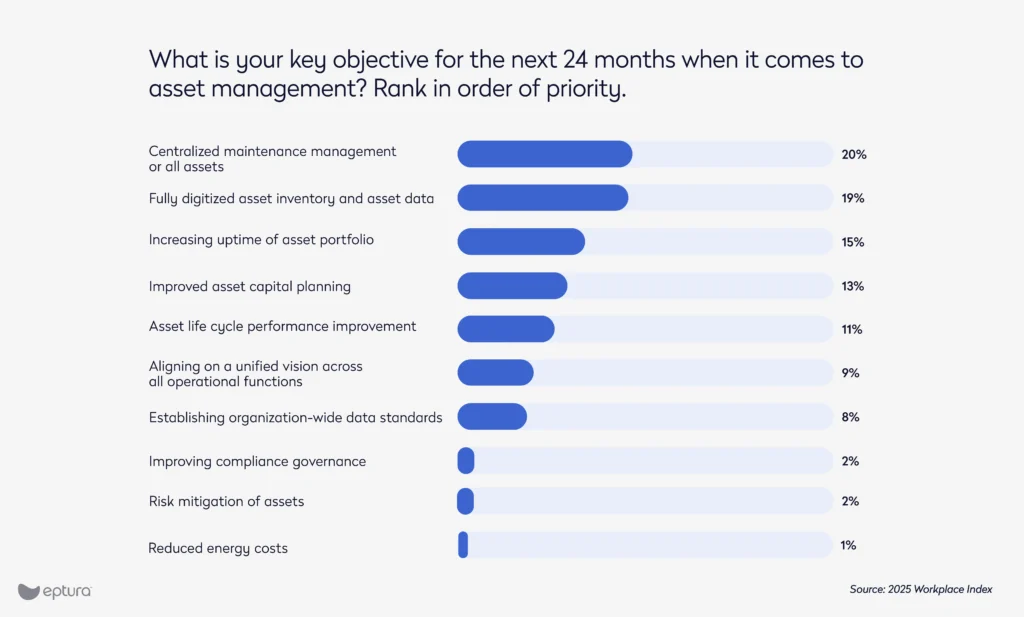
According to the research in the report, another significant goal is fully digitized asset inventory and asset data, cited by 19% of respondents. A fully digitized asset inventory provides a comprehensive and up-to-date record of all assets, which is essential for effective tracking, reporting, and decision-making. Digitization can also enhance transparency, improve accuracy, and facilitate proactive maintenance strategies. Just behind these top two goals, at 15%, is increasing the uptime of the asset portfolio. Ensuring that assets are operational and available when needed is crucial for maintaining productivity and minimizing disruptions. The close results between the top two goals highlight the importance of both centralized management and digitized data in achieving higher asset uptime and overall operational excellence.
How AI-back workflows help teams overcome challenges across the enterprise
There is a lot that each team plans to accomplish, but they’ll first need to navigate a series of challenges. When we asked each of the three groups, “Which of the following is your biggest challenge when it comes to your buildings and facilities operations?”, the responses were:
- Employee experience: Leveling occupancy across the working week
- Buildings and facilities: Optimizing real estate portfolio
- Asset management: Increasing asset lifecycle
In every case, the way past their biggest concerns starts with a unified platform that will empower the organization to unlock the value chain.
Employee experience: Leveling occupancy across the workweek
By ensuring the employees and visitors use spaces consistently throughout the week, organizations can avoid peak congestion and underutilized periods. A balance leads to a more comfortable and productive work environment for employees, reduces the need for additional real estate, and optimizes resource allocation. A well-managed occupancy schedule can also enhance collaboration and communication among teams, as it ensures that meeting spaces and work areas are available when needed.
Real-time occupancy analytics
A unified platform backed by AI workflows is instrumental in leveling occupancy across the working week, creating a balanced and efficient workplace. One of the primary features of such a platform is real-time occupancy analytics, which empowers workplace and facility management teams to leverage AI algorithms to continuously monitor and analyze data from desk booking systems, Internet of Things (IoT) sensors, and employee schedules.
For example, occupancy sensors can detect which desks and meeting rooms are being used and when, providing immediate insights into underutilized spaces and peak congestion times. Facility managers can then use this data to make informed decisions, such as reassigning desks or adjusting meeting room availability to ensure consistent utilization throughout the week. These insights help teams avoid the common issue of overcrowded spaces on certain days and underutilized areas on others.
An intelligent, unified platform also supports collaboration and communication among teams by ensuring that meeting spaces and work areas are available when needed. AI-driven dynamic desk allocation can automatically adjust desk assignments based on employee schedules and preferences, reducing the likelihood of overbooking and ensuring that spaces are used efficiently.
For example, if a team has a recurring meeting on a specific day, the AI might suggest alternative spaces for other teams to avoid conflicts. The platform can also offer personalized recommendations for desk and meeting room bookings, suggesting the best available spaces based on individual needs and past behavior. The system not only improves the user experience but also helps in strategic planning, reducing the need for additional real estate and optimizing resource allocation.
Buildings and facilities: Optimizing the real estate portfolio
By efficiently managing the real estate portfolio, companies can reduce costs, improve space utilization, and ensure that their facilities align with business needs. Optimization can lead to better financial performance, enhanced employee satisfaction, and a more sustainable use of resources. It also allows organizations to adapt quickly to changing business conditions and market demands.
Space utilization analytics
An important feature of an intelligent, unified platform is advanced space utilization analytics, which allows teams to use AI to monitor and analyze how different areas of the office are being used over time. For example, organizations can use the platform to track which desks and meeting rooms are frequently occupied and which remain underutilized, providing detailed reports that help facility managers make data-driven decisions. They can then use the data to reconfigure office layouts, consolidate underused spaces, or even downsize the real estate portfolio, thereby reducing costs and improving overall space efficiency. By aligning the physical space with business needs, the team ensures that every square foot is utilized to its maximum potential, leading to better financial performance and a more sustainable use of resources.
The solution can also help facilitate quick and seamless adaptation to changing business conditions and market demands. Dynamic space management features, such as AI-backed desk and meeting room allocation, can automatically adjust to new employee schedules, project needs, and team sizes. For example, if a company needs to rapidly expand a team or reassign employees to different projects, the platform can quickly reallocate spaces to accommodate these changes without the need for manual intervention. Flexibility not only enhances employee satisfaction by providing a more responsive and adaptable work environment but also ensures the organization can respond to market dynamics, such as remote work trends or increased demand for collaborative spaces.
Asset management: Increasing asset lifecycles

By extending the lifespan of assets, organizations can reduce maintenance costs, minimize downtime, and improve overall operational efficiency. Well-maintained assets are more reliable and perform better, leading to higher productivity and fewer disruptions.
Preventive and predictive maintenance
A unified platform backed by AI workflows is essential for increasing the asset lifecycle, helping asset management teams reduce maintenance costs, minimize downtime, and improve operational efficiency. One of the key features is predictive maintenance, which uses machine learning to analyze historical data and current usage patterns to forecast when equipment is likely to fail. For example, the team can use the platform to monitor the performance of HVAC systems, printers, and other critical assets, identifying potential issues before they become major problems. The proactive approach allows maintenance teams to schedule repairs and replacements during low-occupancy periods, reducing the impact on daily operations and ensuring that assets remain in optimal condition. By extending the lifespan of these assets, organizations can save significant amounts of money on maintenance and replacement costs, leading to higher productivity and fewer disruptions.
They can also use the AI algorithms to generate alerts for routine maintenance tasks, ensuring they stay on top of tasks. And by integrating the system with IoT devices, they can monitor environmental conditions that affect asset longevity, such as temperature and humidity, and adjust these settings to prevent wear and tear.
Intelligent worktech is the right solution for teams across the enterprise
Workplace and facility teams at enterprises have a clear idea of the ways they can best contribute to larger organizational goals. However, they don’t currently have the technology they need to overcome challenges and meet their goals. Data remains difficult to capture and share, making real-time responses and deeper analytics impossible.
“We know the answer to value optimization doesn’t lie with more technology,” writes Brandon Holden, CEO Eptura, in the 2025 Workplace Index report.
By becoming more connected, more informed, and more intelligent, teams can enhance employee experience and optimize facility and asset management.
“With the right technology in place, we believe organizations can now unlock unrivaled value by harnessing the power of one unified solution, cross-platform data analytics, and embedded AI,” Holden explains.
Download the full 2025 Workplace Index report to learn more about these trends and how they directly affect your organization.
